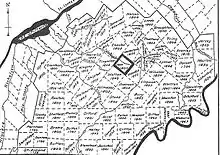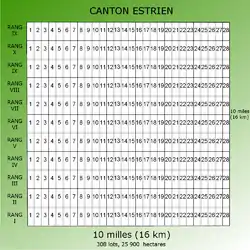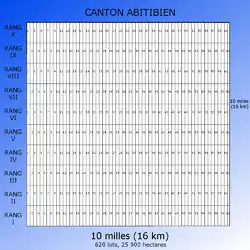Township (Quebec)
A township (French: canton) in Quebec, Canada, is a historical cadastral division of the territory aimed at facilitating the granting of public lands to individuals for the colonization.

Unlike the French seigneurial system in force in New France where royalties are levied, these divisions inherited from the British cadastral system are under the tenure of "franc et commun socage", meaning without royalties to a lord.[1] In this province of Canada, they are for the most part approximately 10 miles by 10 miles except for those located on the banks of a navigable waterway which are 9 miles abreast and 12 miles deep.[1]
History of the implementation of the system
Initially, this attribution system was mainly used in Quebec (Lower Canada) and Ontario (Upper Canada) following the Constitutional Act of 1791 resulting from the arrival of the loyalists of the American revolution.[2] Several administrative regions were divided into townships before being colonized: Estrie, Abitibi-Témiscamingue Saguenay-Lac-Saint-Jean and Côte-Nord.[3] On February 2, 1796 the canton of Dunham is the first canton established in Quebec in the region which will be named "Eastern Townships of Lower Canada" (cantons de l'Est du Bas-Canada).[4][5] The Eastern Townships also form a historic region, in the sense that together they constitute the bloc of the first townships to have been proclaimed on Quebec territory, before the final replacement of the seigneurial regime in 1854. They cut out the whole of the Estrie region and part of the Centre-du-Québec, Chaudière-Appalaches and Montérégie regions.
Today, the cantons no longer represent administrative divisions recognized by the Ministry of Municipal Affairs and Housing (Quebec) (MAMH). Only municipal townships, formed from one or more townships, such as township municipalities and united township municipalities, are recognized.[6] This is not the case in other Canadian provinces such as Ontario where the geographic township is an administrative subdivision of a county.[7] However, several towns and municipalities bear the name, or part of the name, of the township in which they are located, such as Amos, Granby, Joliette, Les Escoumins, North Hatley, Roberval, Thetford Mines, etc. Others bear the name of their respective parish, composed with the name of the canton in which it is formed: Saint-Germain-de-Grantham, Saint-Edmond-de-Grantham, Saint-Denis-de-Brompton, Saint-François-Xavier-de-Brompton, Saint-Jacques-de-Leeds, Saint-Pierre-de-Broughton, etc.
Although the Lord's Amendment Act of 1859 proclaimed the creation of new townships in new regions, in addition to the existing eastern townships, the Quebec cadastre is still divided into townships today. According to the system of distribution of the lots, they organize, together with the provisions relating to agricultural land and protected areas, the development and location of new urbanization plans, in rural and semi-rural regions.[8] Within the urban centres, the maintenance of the current townships serves to organize the municipal development of highways and therefore, to promote respect for acquired rights relating to the ownership of lots.
On the other hand, the cantonal system in Quebec constitutes a main premise in the attribution of the relative responsibility.
Main characteristics of the Quebec township
Canton estrien (Canton de l'Est)

- Technical characteristics of the Estrie canton
- 11 mi by 11 mi (160 km by 16 km)
- 11 rows of 28 lots
- 308 lots
- 25,900 hectare s
- Technical characteristics of the batch
- 588.4 m by 1,478.6 m
- 84.9 hectares
- 5% of the land is reserved for the crown for the construction of roads
- Division
- From the Yamaska River to the Chaudière River and from the Québec-United States border to half of the Bois-Francs territory, namely:
- * Centre-du-Québec (southern half), including cities such as Drummondville;
- * Chaudière-Appalaches (southwest), including cities such as Thetford Mines;
- * Estrie (entire);
- * Montérégie (east-south-east), including cities such as Granby.
See also
References
- Ministry of Natural Resources and Wildlife of Quebec, op. cit., page 52
- Quebec Ministry of Natural Resources and Wildlife, op. cit., page 51
- Quebec Ministry of Natural Resources and Wildlife,, op. cit., page 51-52
- "Cantons". Ministry of Energy and Natural Resources. Retrieved April 19, 2019.
- "Cantons-de-l'Est or Estrie?". Université Laval. Retrieved April 19, 2019.
- Commission de Toponymie du Québec - List of municipalities.
- Map of administrative divisions of southern Ontario.
- C_1/C1.html Cadastre Act (RSQ, c. C-1)
External links
- Quebec Ministry of Natural Resources and Fauna (2004). "Directory of the cantons of Quebec 2004; Annex II, Brief history of the canton system in Quebec" (PDF). Retrieved June 19, 2009.
